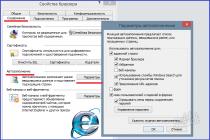The VGA RGB Analog interface with analog base color luminance signals allows for the transmission of 2 24 @ 16.7 million colors. To reduce crosstalk, these signals are transmitted over twisted pairs, with their own return lines (Return). Each signal pair in the monitor is loaded with a resistor to match the cable. The black color of a pixel on the monitor corresponds to the zero potential on the lines of all colors, the full brightness of each color corresponds to a level of either 0.7 V or 1 V (optional). Synchronization, control, state signals are transmitted by TTL levels. The timing diagrams of the VGA RGB Analog interface are shown in Fig. 2.46.
Rice. 2.46 Timing Diagrams of RGB Analog Interface:
a - line scan; b - code scan; c - the general picture
In fig. 2.46 RGB signals are shown conditionally: the time intervals are shown in which the signals lead to the illumination of the screen points, the rest of the time the RGB inputs are forcibly locked with a special voltage. The values of time intervals a, b, c, d, e, f, g, h are determined by the video system mode. The VESA standard DMT (Discrete Monitor Timing 1994–1998) defines a discrete set of parameter options for the corresponding video mode. The later VESA GTF (Generalized Timing Formula Standard) standard specifies formulas for determining all synchronization parameters depending on the screen format in pixels, the need for additional visible frames (Overscan Borders), the type of scan (progressive or interlaced), and the frame rate.
VGA and SVGA video adapters use a small 15-pin DB15 connector. Signals Red, Green, Blue, Red Return, Green Return, Blue Return, HSync, VSync, GND and either IDO ¸ ID3, or VESA DDC signals: SDA, SCL are brought out to the connector pins.
Note that Macintosh computers also use the DB15 connector to connect the monitor, the DB15P part is installed on the monitor and the pin assignment is different.
In addition to the luminance signals of the basic colors and synchronization, the data required to automate the coordination of the parameters and modes of the monitor and the computer is also transmitted via the interface. The interests of the computer are represented by the video adapter. It provides monitor identification required for PnP support and monitor power management.
For the simplest identification of the monitor in the interface, four logical signals IDO-ID3 were first introduced, by which the video adapter could determine the type of connected IBM-compatible monitor. However, of these signals, only the ID1 signal was used, which was used to determine the fact of connecting a monochrome monitor. In principle, a monochrome monitor can be recognized by a video adapter by the absence of load on the Red and Blue lines.
Therefore, the parallel identification of monitors was replaced by a serial one: the VESA DDC (Display Data Channel) digital interface channel. This channel is built on the I 2 C (DDC 2B) or ACCESS.BUS (DDC 2AB) interfaces, which require only two TTL signals —SCL and SDA. DDC channels transmit the identification parameters of the monitor.
Monitor identification data is stored in nonvolatile memory in the monitor. The structure of the Extended Display Identification Data (EDID) parameter block is the same for any DDC implementation: header (indicator of the beginning of the EDID stream); product identifier (assigned by the manufacturer); EDID version; basic parameters and capabilities of the display; set synchronization parameters; sync parameter descriptors; extension flag; check sum.
Despite the widespread distribution of digital networks, analog data transmission channels are still in use. There are several reasons for this.
In industrial automation systems, there are a large number of devices designed and manufactured many years ago that use analog data transmission channels. These can be sensors, actuators (valves, pumps), as well as recording devices (recorders). Replacement of this equipment is slow and requires a very large capital investment. In addition, the transfer of an enterprise entirely to digital networks means one-step replacement of almost all equipment and information cable networks. Such a large-scale reconstruction requires not only huge funds, but also stopping the production process, which in many cases is unacceptable. Therefore, when creating or modernizing automatic control systems, it is necessary to use analog data transmission channels to receive information from sensors and transfer control to actuators.
Advantages
The main advantage of using the 4 ... 20 mA current loop as the data transfer interface from the sensors is the use of only two wires for connection to the data acquisition system. In addition, unlike digital interfaces, additional hardware and software tools for the implementation of a standard communication protocol or additional settings (for example, programming an address) during installation.
Current or voltage

Rice. 1.
At the same time, the use of analog interfaces with intelligent sensors (in which microcontrollers are built for signal preprocessing) or actuators with an analog interface, which must be controlled by a digital controller, requires the use of a digital-to-analog converter. Considering that in various cases both current and potential interfaces can be used, to simplify the circuit and reduce its cost, it is advisable to choose a DAC chip capable of providing both types of output signals without additional elements.
This is the microcircuit of a specialized sixteen-bit digital-to-analog converter MAX5661(see fig. 2).

Rice. 2.
The capabilities of the microcircuit sharply distinguish it from similar devices. It should be noted that it is capable of generating both current signals in the range of 0 ... 20/4 ... 20 mA and potential (including in a 4-wire circuit with compensation of the resistance of connecting wires) with an amplitude of up to ± 10 V, and the initial zero offset does not exceed 0.1%, and the total error is not more than 0.3% of the full scale. The transfer characteristic of the DAC has guaranteed monotonicity, which is extremely important for closed-loop controllers.
When designing the microcircuit, it was decided to use an external source of 4.096 V reference voltage.This is due to the fact that during the operation of the DAC, the crystal temperature can change significantly, which can have a significant effect on the parameters of the built-in reference voltage and significantly reduce the accuracy of the system as a whole. This temperature change is especially pronounced at the current output at high supply voltage (which can be up to 40 V) and low load resistance, since the output transistor of the voltage-current converter is built into the microcircuit. With a small bit depth of the DAC, this would not have of great importance however, for 16-bit systems, moving the voltage reference outside the main die can significantly improve accuracy.
Another advantage of the described IC is the use of a high-speed (up to 10 MHz) serial SPI / QSPI / Microwire interface for communication with the control microcontroller, and it is possible to connect several microcircuits in series (Daisy Chaining). There is a FAULT output, which becomes active when the voltage output is short-circuited or the current loop is broken. Information about the alarm state of the outputs is also available via the serial interface. The output stages of the microcircuit can be configured using software or using special inputs that are connected to ground or to the supply voltage (+5 V nom.).
The MAX5661 microcircuit also has two inputs for asynchronous control. One of them - CLR - allows you to either reset the DAC, or load a preset value (determined by software). Another - LDAC - allows you to load the value of the input data register. Both inputs can be used for simultaneous asynchronous control of several microcircuits.
Conclusion
Analog information transmission has retained its popularity in the traditionally conservative industrial field of application. This is confirmed by the fact that chip manufacturers continue to offer new integrated solutions for its implementation.

Receiving technical information, ordering samples, delivery -
e-mail:
Analog interfaces allow you to connect standard consumer equipment, microphone, analog CD-ROM output. On most consumer cards for analog signals small-sized connectors are used - "mini-jacks" (jack) with a diameter of 3.5 mm, mono and stereo. These connectors are universal (used on household equipment), but they have a very low quality of contacts - they are a source of noise (rustles and crackles), and also sometimes
8.5. Audio device interfaces _______________________________________ 343
just lose contact. Their full-size 6-mm "relatives", typical for professional equipment, have a very high quality, but due to their large size, they are not used on sound cards. On some high-end cards, the line-in and line-out signals are routed to a pair of RCA connectors, which provide very good contact, especially in the gold-plated version. In common parlance, such connectors, often used on consumer VCRs, are called "bells" or "tulips".
The layout of the chains on the mini-jacks is unified: the left channel is on the central contact, the shield (ground) is on the outer cylinder, and the right channel is on the intermediate cylinder. If the stereo jack is plugged into a mono jack and vice versa, the signal will only go to the left channel. All connections in stereos are made with "straight" cables (connector pins are connected "one-to-one"). There is no single approach to connect the center and bass channels in a 6-speaker system - a crossover cable may be required. Incorrect connection will be noticeable by the "squeak" woofer(subwoofer) and "mumbling" of the center speaker.
Connecting devices to a sound card via external connectors usually does not cause problems - they are unified, and it is enough to know the purpose of the connectors marked on the rear panel.
♦ Line In - line input from a tape recorder, tuner, turntable, synthesizer, etc. The sensitivity is about 0.1-0.3 V.
♦ Line out- linear signal output to an external amplifier or tape recorder, the signal level is about 0.1-0.3 V.
♦ Speaker Out - exit to acoustic systems or headphones. It is impractical to connect an external power amplifier to it, since here the distortion is greater than at the linear output.
♦ Mgs In- microphone input, sensitivity 3-10 mV. This input is usually monaural, but sometimes a three-pin jack is used (as in stereo), with an auxiliary pin (in place of the right channel) dedicated to supply power to the electret microphone.
Connection internal devices to analog inputs can be more troublesome. For this, four-pin connectors are used, which differ in both the pitch between the pins and their purpose. To connect a CD-ROM, two or even three connectors with signal contacts connected in parallel are often placed side by side, but this may not help if the cable has a different signal arrangement. It can be saved by rearranging the contacts on the cable connector, for which a needle is pressed on the locking protrusion of the contact. After that, the contact can be pulled out towards the cable and rearranged into another socket. The type and options for the location of the signal contacts of the audio inputs are shown in Fig. 8.15. For completeness, let's add that the connector may have a key on the opposite side (by mistake of the cable assembler or according to the internal standard of its manufacturer). The task of connecting is still not hopeless, since it requires the correct placement of only two signal contacts, and the contacts of the common wire are isolated
Modern computers are highly capable of working with video, and their owners often watch movies on the monitor screen. And with the advent of barebone multimedia platforms aimed at using as a home media center, the interest in connecting audio and video equipment is only growing.
It is much more convenient and practical to watch the video on big screen TV, especially since almost all modern video cards are equipped with a TV-out.
The need to connect a TV to a computer also arises when editing amateur video. As you can easily see in practice, the picture and sound on a computer are significantly different from those that you will later see and hear on TV. Therefore, all video editors allow you to view preliminary editing results on a television receiver directly from the working scale even before creating a movie. Experienced video enthusiasts constantly monitor the picture and sound by displaying them on a television screen, not on a computer monitor.
Topics such as setting up video cards, choosing an image standard, as well as comparing the quality of video outputs of video cards from different manufacturers and solving the problems that arise are beyond the scope of this article - here we will consider only the following questions: what connectors can be found on a TV and on a video card, how they agree with each other and what are the ways to connect a computer to a TV.
Display interfaces
Classic analog interface (VGA)
Computers have been using the 15-pin analog D-Sub HD15 (Mini-D-Sub) interface for quite some time, which is traditionally called the VGA interface. The VGA interface carries red, green, and blue (RGB) signals, as well as horizontal scan (H-Sync) and vertical sync (V-Sync) information.
All modern video cards have such an interface or provide it with an adapter from the universal combined DVI-I (DVI-integrated) interface.
Thus, both digital and analog monitors can be connected to the DVI-I connector. A DVI-I to VGA adapter is usually included with many graphics cards and allows you to connect older monitors with a 15-pin D-Sub (VGA) plug.

Please note that not every DVI interface supports analog VGA signals, which can be obtained through these adapters. Some video cards have a digital DVI-D interface to which you can connect only digital monitors. Visually, this interface differs from DVD-I by the absence of four holes (pins) around the horizontal slot (compare the right side of the white DVI connectors).

Often modern graphics cards are equipped with two DVI outputs, in which case they are usually universal - DVI-I. Such a video card can simultaneously work with any monitors, both analog and digital in any set.

DVI digital interface
The DVI interface (TDMS) was designed primarily for digital monitors that do not require the graphics card to convert digital signals to analog signals.

But as the transition from analog to digital displays is slow, graphics hardware designers tend to use these technologies in parallel. In addition, modern video cards can work with two monitors at the same time.
The universal interface DVI-I allows you to use both digital and analog connections, while DVI-D only allows digital connections. However, the DVI-D interface is quite rare today and is usually used only in cheap video adapters.
In addition, DVI digital connectors (both DVI-I and DVI-D) have two varieties - Single Link and Dual Link, which differ in the number of contacts (in Dual Link, all 24 digital contacts are involved, and in Single Link - only 18 ). Single Link is suitable for use in devices with resolutions up to 1920x1080 (full HDTV resolution), for b O higher resolutions already require Dual Link, which allows you to double the number of displayed pixels.
HDMI digital interface
The digital multimedia interface HDMI (High Definition Multimedia Interface) was developed jointly by a number of large companies - Hitachi, Panasonic, Philips, Sony and others. The 19-pin version of HDMI is widely used today to transmit high-definition television (HDTV) signals with a resolution of up to 1920x1080 (1080i ). Higher resolution video signals require Type B 29-pin connectors. In addition, HDMI can provide up to eight channels of 24-bit 192 kHz audio and has a built-in Digital Rights Management (DRM) copyright protection mechanism.

HDMI is relatively new, but it has quite a few competitors in the computer sector, both from the traditional DVI interface and from newer and more advanced interfaces such as UDI or DisplayPort. However, products with HDMI ports are steadily moving into the market, as modern consumer video equipment is increasingly equipped with HDMI connectors. Thus, the growing popularity of multimedia computing platforms will stimulate the emergence of graphics and motherboards with HDMI ports, even though computer manufacturers have to buy a rather expensive license to use this standard and also pay some flat royalties for each product sold with an HDMI interface. ...
License fees also increase the cost of products with HDMI ports for the end manufacturer - for example, a video card with an HDMI port will cost about $ 10 more. In addition, it is unlikely that an expensive HDMI cable ($ 10-30) will be included in the package, so you will have to purchase it separately. However, there is hope that with the rise in popularity HDMI interface the amount of such a mark-up will gradually decrease.
HDMI uses the same TDMS signal technology as DVI-D, so inexpensive adapters are available for these interfaces.

And while the HDMI interface has not yet replaced DVI, such adapters can be used to connect video equipment via the DVI interface. Please note that HDMI cables cannot be longer than 15m.
New UDI
At the beginning of this year, Intel announced a new digital interface UDI (Unified Display Interface) for connecting digital monitors to a computer. So far, Intel has just announced the development of a new type of connection, but in the near future it plans to completely abandon the old analog VGA interface and connect computers to display devices through a new digital interface UDI, recently developed by the engineers of this company.

The creation of the new interface is due to the fact that both the analog VGA interface and even the digital DVI interface, in the opinion of Intel representatives, are hopelessly outdated today. In addition, these interfaces do not support the latest content protection systems found in next generation digital media such as HD-DVD and Blu-ray.
Thus, UDI is almost analogous to the HDMI interface used to connect computers to modern HDTVs. The main (and perhaps the only) difference between UDI and HDMI will be the absence of an audio channel, that is, UDI will transmit only video and is entirely designed to work with computer monitors, not HD-TVs. In addition, Intel appears to be unwilling to pay royalties for every HDMI device it produces, so UDI is a good alternative for companies looking to keep their products cheaper.
The new interface is fully compatible with HDMI, and will also support all currently known content protection systems, which will allow the smooth playback of new media equipped with copy protection.
New DisplayPort interface
Another new video interface, DisplayPort, has recently been approved by the Video Electronics Standards Association (VESA).
The open DisplayPort standard has been developed by a number of large companies, including ATI Technologies, Dell, Hewlett-Packard, nVidia, Royal Philips Electronics, and Samsung Electronics. It is assumed that in the future, DisplayPort will become a universal digital interface that allows you to connect displays of various types (plasma, liquid crystal, CRT monitors, etc.) to household devices and computer equipment.

The DisplayPort 1.0 specification provides for the possibility of simultaneous transmission of both video signal and audio streaming (in this sense new interface completely analogous to HDMI). Note that the DisplayPort maximum throughput is 10.8 Gbps, with a relatively thin four-conductor interconnect cable used for transmission.
Another feature of DisplayPort is its support for content protection functions (similar to HDMI and UDI). Built-in security controls allow the content of a document or video file to be displayed only on a limited number of “authorized” devices, which theoretically reduces the likelihood of illegal copying of copyrighted material. Finally, the new standard connectors are thinner than today's DVI and D-Sub connectors. This will allow DisplayPorts to be used in small form factor hardware and easily build multi-channel devices.
DisplayPort support has already been announced by Dell, HP and Lenovo. Most likely, the first devices equipped with new video interfaces will appear before the end of this year.
Video connector on graphics card
On modern video cards, in addition to connectors for connecting monitors (analog - D-Sub or digital - DVI), there is a composite video output ("tulip"), or a 4-pin S-Video output, or a 7-pin combined video output ( both S-Video and composite inputs and outputs).

In the case of S-Video, the situation is simple - there are S-Video cables or adapters for other SCART connectors on sale.
However, when a non-standard 7-pin connector is found on video cards, then in this case it is better to keep the adapter that comes with the video card, because there are several wiring standards for such a cable.

Composite video (RCA)
The so-called composite video output has long been widely used to connect consumer audio and video equipment. The connector for this signal is usually referred to as RCA (Radio Corporation of America), and popularly referred to as "tulip" or VHS connector. Please note that not only composite video or audio, but also many other signals such as component video or high definition television (HDTV) can be transmitted with such plugs in video equipment. Typically, tulip plugs are color-coded to help users navigate the bundle of wires. Common meanings of colors are given in table. 1.
Table 1
|
Usage |
Signal type |
|
|
White or black |
Sound, left channel |
Analog |
|
Sound, right channel |
Analog |
|
|
Video, composite signal |
Analog |
|
|
Luminance Component Signal (Luminance, Luma, Y) |
Analog |
|
|
Chrominance, Chroma, Cb / Pb Component Signal |
Analog |
|
|
Chrominance Component (Chrominance, Chroma, Cr / Pr) |
Analog |
|
|
Orange / yellow |
SPDIF digital audio |
Digital |

Composite wires can be long enough (simple adapters can be used to extend wires).

However, the use of low quality connections and sloppy "tulip" switching is gradually becoming a thing of the past. In addition, cheap RCA connectors on equipment often break. Today, other types of switching are increasingly used on digital audio and video equipment, and even when transmitting analog signals, it is more convenient to use SCART.
S-Video
Often the video card and TV have a four-pin S-Video connector (Y / C, Hosiden), which is used to transmit video signals of higher quality than composite. The fact is that the S-Video standard uses different lines to transmit luminance (the luminance and data sync signal is denoted by the letter Y) and color (the chroma signal is denoted by the letter C). Separation of luminance and color signals allows to achieve better picture quality in comparison with the composite RCA-interface ("tulip"). Higher quality analog video can only be achieved with completely separate RGB or component interfaces. To receive a composite signal from S-Video, a simple S-Video to RCA adapter is used.

If you do not have such an adapter, then you can make it yourself. However, there are two options for outputting a composite signal from a video card equipped with an S-Video interface, and the choice depends on the type of your video card. Some cards can switch output modes and send a simple composite signal to the S-Video output. In the mode of supplying such a signal to S-Video, you just need to connect the pins to which the composite signal is supplied with the corresponding tulip outputs.

The RCA cable routing is simple: the center conductor carries the video signal, and the outer braid is the ground.
The S-Video wiring is as follows:
- GND - "ground" for the Y-signal;
- GND - "ground" for the C-signal;
- Y - luminance signal;
- C - chrominance signal (contains both color difference).
If the S-Video-out can work in the composite signal supply mode, then the second pin of its connector is connected to ground, and the fourth - the signal. On a collapsible S-Video plug, which is required to make an adapter, the contacts are usually numbered. Jack and plug connectors are numbered mirrored.
If the video card does not have a composite signal output mode, then to obtain it, you will have to mix the chroma and luminance signal from the S-Video signal through a 470 pF capacitor. The signal received in this way is fed to the central core, and the "ground" from the second contact is fed to the braid of the composite cord.
SCART
SCART is the most interesting combined analog interface and is widely used in Europe and Asia. Its name comes from the French abbreviation proposed in 1983 by the Union of Developers of Radio and Television Equipment of France (Syndicat des Constructeurs d'Appareils, Radiorecepteurs et Televiseurs, SCART). This interface combines analog video (composite, S-Video, and RGB), stereo audio, and control signals. Today, every TV or VCR produced in Europe is equipped with at least one SCART socket.

For the transmission of simple analog signals (composite and S-Video), there are many different SCART adapters on the market. This interface is convenient not only because everything is connected using only one cable, but also because it allows you to connect a high-quality RGB video source to a TV without intermediate encoding into composite or S-Video signals and get the best image quality on a consumer TV screen. (the picture and sound quality when fed through SCART is noticeably superior to that of any other analog connections). This possibility, however, is not realized in all VCRs and TVs.
In addition, the developers have incorporated in the SCART interface additional features by reserving a few contacts for the future. And since the SCART interface has become a standard in European countries, it has acquired several new features. For example, with the help of some signals on pin 8, you can control the TV modes via SCART (switch it to "monitor" mode and vice versa), switch the TV to work with RGB signals (pin 16), etc. Pins 10 and 12 are for digital data transmission via SCART, which makes the number of commands practically unlimited. There are several well-known SCART communication systems: Megalogic, used by Grundig; Easy Link from Philips; SmartLink from Sony. True, their use is limited to communication between the TV and the VCR of these companies.
By the way, the standard provides for four types of SCART cables: type U - universal, providing all connections, V - without sound signals, C - without RGB signals, A - without video and RGB signals. Unfortunately, modern component modes (Y, Cb / Pb, Cr / Pr) are not supported in the SCART standard. However, some manufacturers of DVD players and large-format TVs build in the ability to transmit via SCART and component video, which is transmitted through the pins used in the standard for RGB-signal (however, this feature is practically the same from connecting via RGB).
Various adapters are available for connecting composite or S-Video sources to SCART. Many of them are universal (bi-directional) with an I / O switch.

There are also simple unidirectional adapters, mono or stereo adapters, and connectors for switching control. In the case when it is necessary to connect two devices at once to one device, you can use a SCART splitter in two or three directions. Those who are not satisfied with the proposed options or who are not available can make their own in accordance with the pin assignments in SCART, given in table. 2.
The pin numbering is usually indicated on the connector:

Of course, computers do not use a SCART connector, however, knowing its specification, you can always make an appropriate adapter for using an analog computer monitor as a receiver of a video signal from a tape recorder or, on the contrary, for supplying a video signal from a computer to a TV equipped with a SCART connector.
For example, in order to input or output a composite signal from a SCART connector, you need to take a coaxial cable with a characteristic impedance of 75 ohms and distribute the outer braid (ground) and the inner core (composite signal) on the SCART connector.
Video signal output from computer to TV (TV-OUT):
- the composite signal is fed to pin 20 of the SCART connector;
To input video signal from a VCR to a computer (TV-IN):
- composite signal - to the 19th pin of the SCART connector;
- "Ground" - to the 17th pin of the SCART connector.
The correspondence of contacts in the manufacture of an adapter for S-Video is also indicated in table. 2.
Video signal output from a computer to a TV via S-Video (TV-OUT):
- 3rd S-Video pin - 20th SCART pin;
Video signal input from a VCR to a computer via S-Video (TV-IN):
- 1st S-Video pin - 17th SCART pin;
- 2nd S-Video pin - 13th SCART pin;
- 3rd S-Video pin - 19th SCART pin;
- 4th S-Video pin - 15th SCART pin.
To connect a computer to a TV via RGB, it is necessary that the computer outputs an RGB signal in a form that the TV can understand. Sometimes the RGB signal is fed through a dedicated 7-, 8-, or 9-pin composite video output. In this case, the video card settings should be able to switch the video output to RGB mode. If the video output on a video card has seven pins (such a plug is called a mini-DIN 7-pin), then in normal mode the S-Video signal is fed to exactly the same pins as in a regular four-pin S-Video connector. And in RGB mode, signals can be distributed to contacts different ways depending on the manufacturer of the video card.
As an example, we can give the correspondence of the contacts of one of these 7-pin connectors with SCART (this layout is used on some video cards based on the NVIDIA chip, but on your video card it may be different):
- 1st pin mini-DIN 7-pin (GND, "ground") - 17th pin SCART;
- 2nd pin mini-DIN 7-pin (Green, green) - 11th pin SCART;
- 3rd pin mini-DIN 7-pin (Sync, sweep) - 20th pin SCART;
- 4th pin mini-DIN 7-pin (Blue, blue) - 7th pin SCART;
- 5th pin mini-DIN 7-pin (GND, "ground") - 17th pin SCART;
- 6th pin mini-DIN 7-pin (Red, red) - 15th pin SCART;
- 7th pin mini-DIN 7-pin (+3 V RGB mode control) - 16th pin SCART.
All types of adapters require the use of high quality 75 Ohm cables.
There is no video connector on the graphics card
If your video card does not have a TV output, then, in principle, you can connect a TV to a regular VGA connector. However, in this case, you will need electrical circuit signal matching (in the general case, however, simple). There are special devices on the market that convert ordinary computer VGA signals to RGB and to a scan (sync) signal for the TV. Such a device is connected to a VGA cable between a computer and a monitor and duplicates the signal that goes through the VGA output.
In principle, such a device can be made independently. The correspondence between VGA and SCART signals will be as follows:
- VGA SCART PIN SCART Description;
- VGA RED - to the 15th SCART pin;
- VGA GREEN - to the 11th SCART pin;
- VGA BLUE - to the 7th SCART pin;
- VGA RGB GROUND - on the 13th, or 9th, or 5th SCART pin;
- VGA HSYNC & VSYNC - on the 16th and 20th SCART pins.
You will also need to apply + 1-3 V to the 16th SCART pin and 12 V to the 8th SCART pin to switch to AV mode with an aspect ratio of 4: 3.
However, a direct connection will most likely not work and for synchronization you will have to make an electrical circuit, as shown at http://www.tkk.fi/Misc/Electronics/circuits/vga2tv/circuit.html or http: //www.e.kth .se / ~ pontusf / index2.html.














